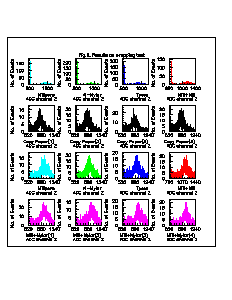Results on Wrapping Test
Jingtang HE
(September 2002)
We made a wrapping test by using Tyvec, Al-Mylar, Milipore, Milipore plus
one layer of Al-Mylar, two layers of Milipore, two layers of Teflon and two
layers of Teflon plus one layer of Al-Mylar as reflector and Cosmic Ray as
radiation source. The white copy paper was used as reference. We took 5
days cosmic ray data by using copy paper as reflector to test the stabiliy
of the set up. All of data was taken by the same crystal and PMT, coupled by
optical grease. About 24 hour data taking is used as a period of a run.
1) Set Up.(see Fig.1.)
2) Results.(see Fig.2.)
The mean value and sigma for pedestal and cosmic ray peak are obtained from
the fitting by a Gaussian function.
--------------------------------------------------------------------------
File Name Pedestal Cosmic Ray peak
reference mean sigma mean sigma C-Ped Change Comment
crystal_5513 512.61 2.94 848.78 76.36 336.17 -6.01 -1.8% Copy Paper
crystal_5514 512.22 2.60 847.22 77.04 335.00 -7.18 -2%
crystal_5515 511.88 2.61 853.12 78.37 341.24 -0.94 -0.3%
crystal_5516 511.72 2.65 854.24 77.47 342.52 +0.34 +0.01%
crystal_5517 511.54 2.56 867.53 76.33 355.99 13.81 +4%
-----------------------------------------------------------------------------
Average 511.99 2.67 854.19 77.11 342.18 Copy Paper
-----------------------------------------------------------------------------
tyvec_5519 511.18 2.41 918.08 83.85 406.90 64.72 +18.9% Tyvec
mylar_5521 510.83 2.33 909.66 86.92 398.83 56.65 +16.6% Al-Mylar
millipo_5524 511.03 2.33 956.34 98.96 445.31 103.13 +30.1% Milipore,no gap
Onemilli5529 512.20 3.01 944.98 84.17 432.78 90.60 +26.5% 1-layer Milipore
-----------------------------------------------------------------------------
crystal_5531 509.29 1.74 975.75 91.74 466.46 124.23 +36.3% Milipore + Mylar
crystal_5533 509.43 1.84 973.63 96.26 464.42 122.02 +35.7%
crystal_5534 513.13 2.32 977.90 89.94 464.78 122.60 +35.8%
crystal_5535 513.00 2.33 987.58 82.82 474.58 132.40 +38.7%
-----------------------------------------------------------------------------
crystal_5539 679.94 3.63 1175.6 95.41 495.66 153.48 +44.9% 2-layer Milipore
-----------------------------------------------------------------------------
crystal_5541 677.48 3.16 1084.4 88.79 406.92 64.74 +18.9% 2-layer Teflon
crystal_5551 680.85 3.14 1097.7 107.2 416.85 74.67 +21.8% 2-Teflon + Mylar
3) Mechanical Properties and Handling Difficulties
-----------------------------------------------------------------------------
Tyvec Al-Mylar Millipore Teflon
-----------------------------------------------------------------------------
Mechanical Very Very Easy to split
Properties Good Good open
-----------------------------------------------------------------------------
Handling Easy Difficult Difficult to shape Difficut to
Difficulties to shape to shape and easy to split open shape
-----------------------------------------------------------------------------
4) Suggestion
Summing up all information above, I would like to suggest to use one layer
of Milipore plus one layer of Al-Mylar or two layers of Milipore as reflector
in PrimEx experiment, since it can give more light, that will improve the
energy resolution, but it is difficult to handle, because Milipore is easy to
split open.
 PS
PS
Thu Sep 19 14:25:34 EDT 2002
 PS
PS